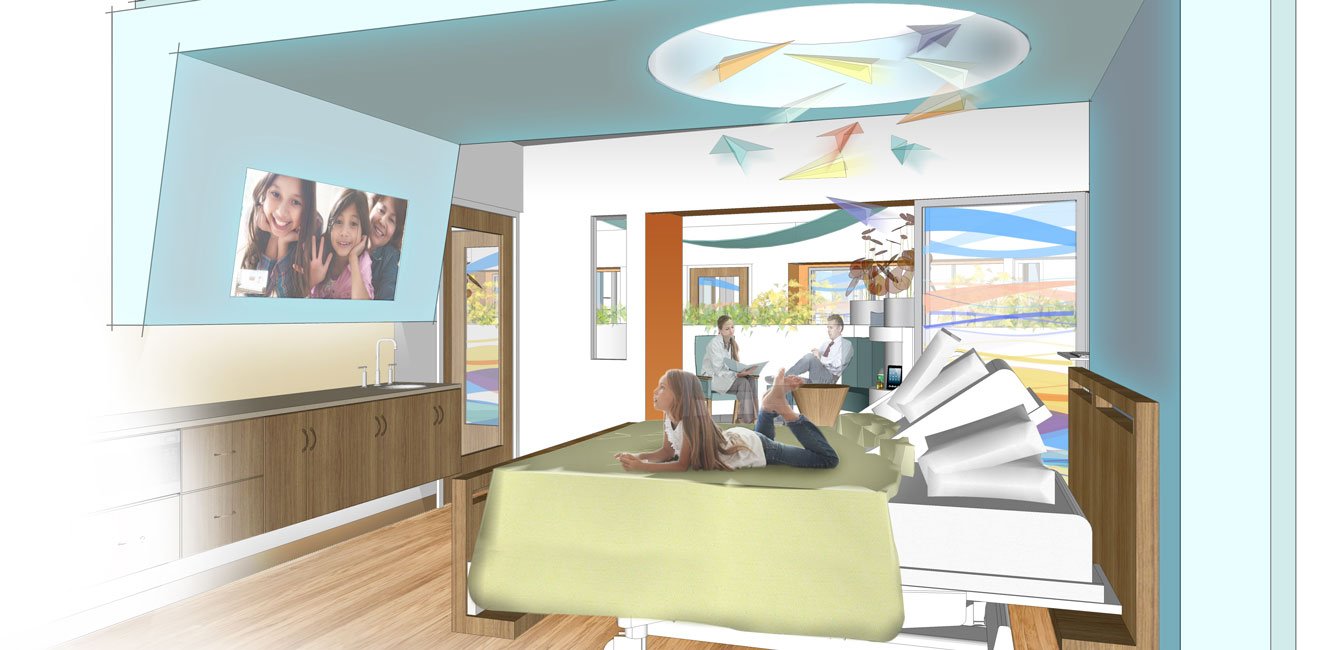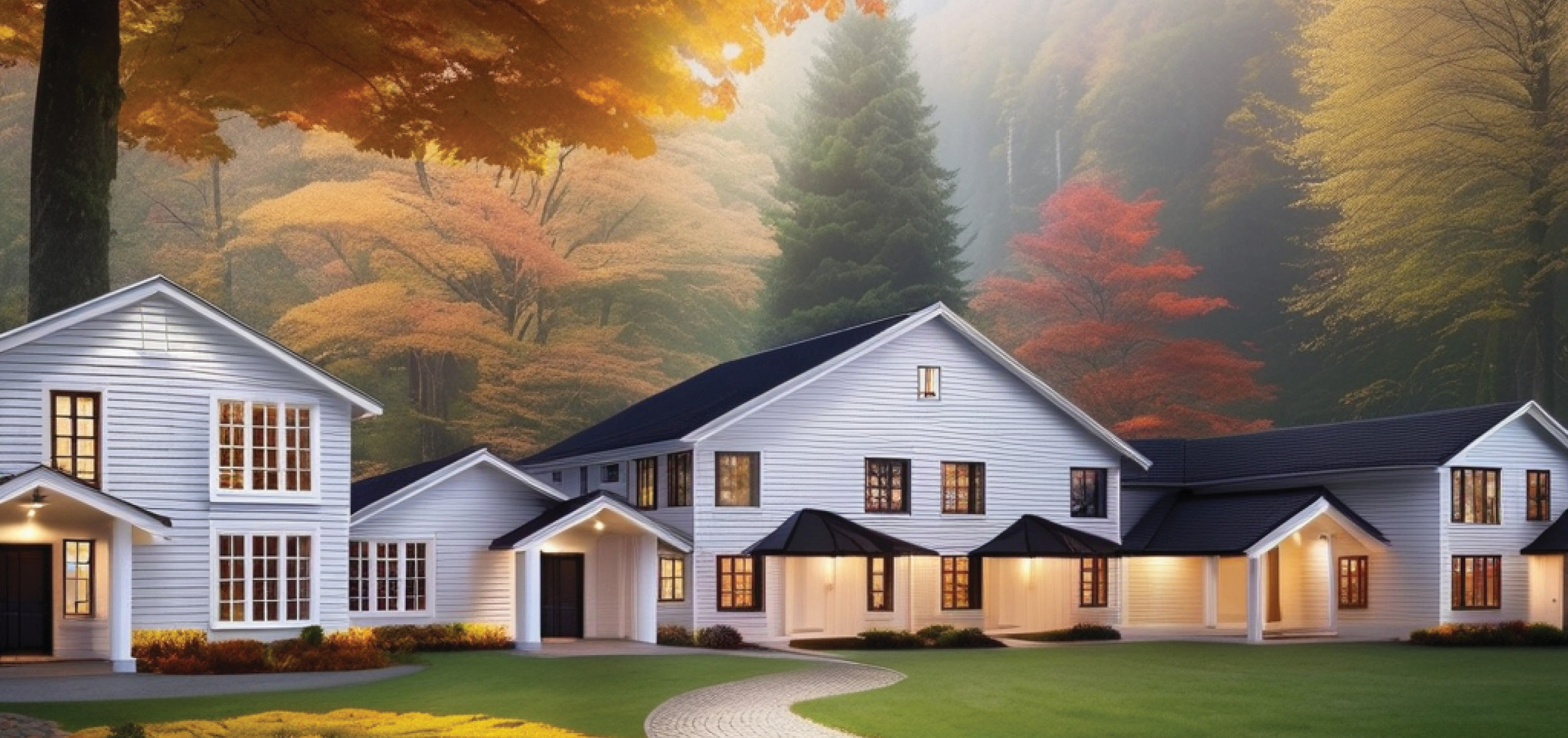In the eyes of a parent of a pediatric oncology patient, the lines between inpatient, outpatient, and the families of caregivers surrounding fellow patients under treatment can blur over the months of treatment their child is receiving. Cohorts of caregivers and patients undergoing treatment, along with the team of clinicians that often become an extended family make up the unique ecosystem of pediatric oncology care.
Unfortunately, the current standards of planning and design for oncology units do not take into account the homes they become for the patients under care and their loved ones. As our industry uncovers more empirical evidence that caregiver presence and well-designed spaces support improved patient outcomes, it is time for us as the creators of these environments to question conflicting, outmoded design standards. Providers are recognizing this as well, in light of a shift to a patient-centered, consumer-driven market and reimbursement based on patient satisfaction.
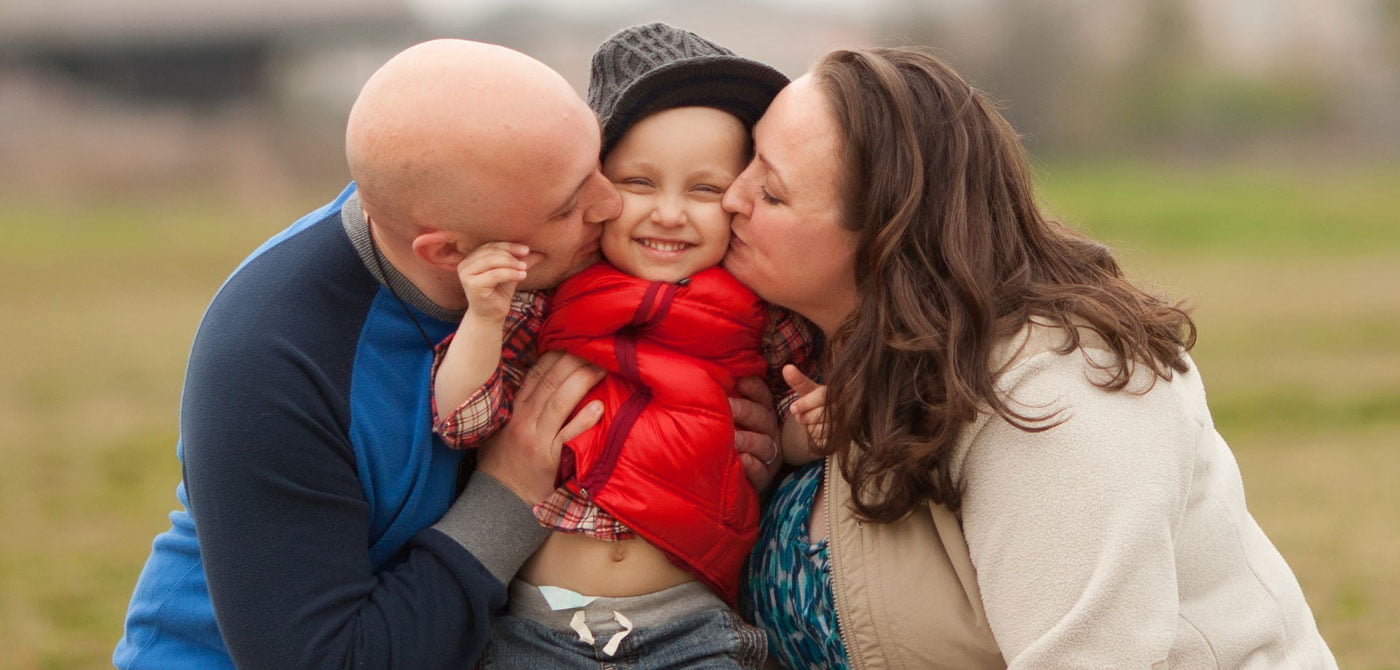
Hendo's Story
This thinking provided the backdrop for the Institute for Patient-Centered Care’s 2014 Family-Centered Cancer Care Design Competition. The story that inspired the goal of the competition, contributed by Dr. Rozeanne “Roze” Hug Wille, is compelling to anyone when they are introduced to it. Hendrix Wille, known as “Hendo” to his family, was diagnosed with Acute Myeloblastic Leukemia (AML) when he was two years old. AML is a rare form of cancer, with a survival rate of 50% after a bone marrow transplant. This suddenly placed Dr. Wille on the patient side of the healthcare and led to many outpatient visits and multiple hospital stays that sometimes lasted months over the next couple of years.
His inpatient room became his family’s home, which was often a challenge in light of the small space and makeshift accommodations for his mom and dad.
As a result of their experience, Hendo’s family wishes to influence healthcare for the better, so they contributed their story to inspire a competition to design a new type of care environment that would better foster caregivers and young patients and improve their outcomes.
Driven by a whole host of influences in the marketplace (from insurance to reimbursement concerns to operational efficiency models) healthcare is embracing an ambulatory strategy, moving the treatment and care of patients into outpatient settings and away from inpatient care environments. Cancer care environments, specifically infusion services, are doing the same; however, this service is more often tethered to hospital inpatient settings due to the higher acuity of patients and patients requiring isolation due to compromised immune systems during treatment. Bone marrow transplants are done in hospitals and due to the treatment and recovery process, patients and their families will experience long lengths of stays. By one report, the average length of stay for bone marrow transplant patients is 37 days.1 Unfortunately, hospitals and these environments of care are not planned and designed to accommodate long lengths of stay, often causing the patient and their families to endure challenging situations, additional stress and discomfort. The results are lower satisfaction scores, longer lengths of stay and complications to the patient condition – all attributed to the poor physical qualities of the environment of care.
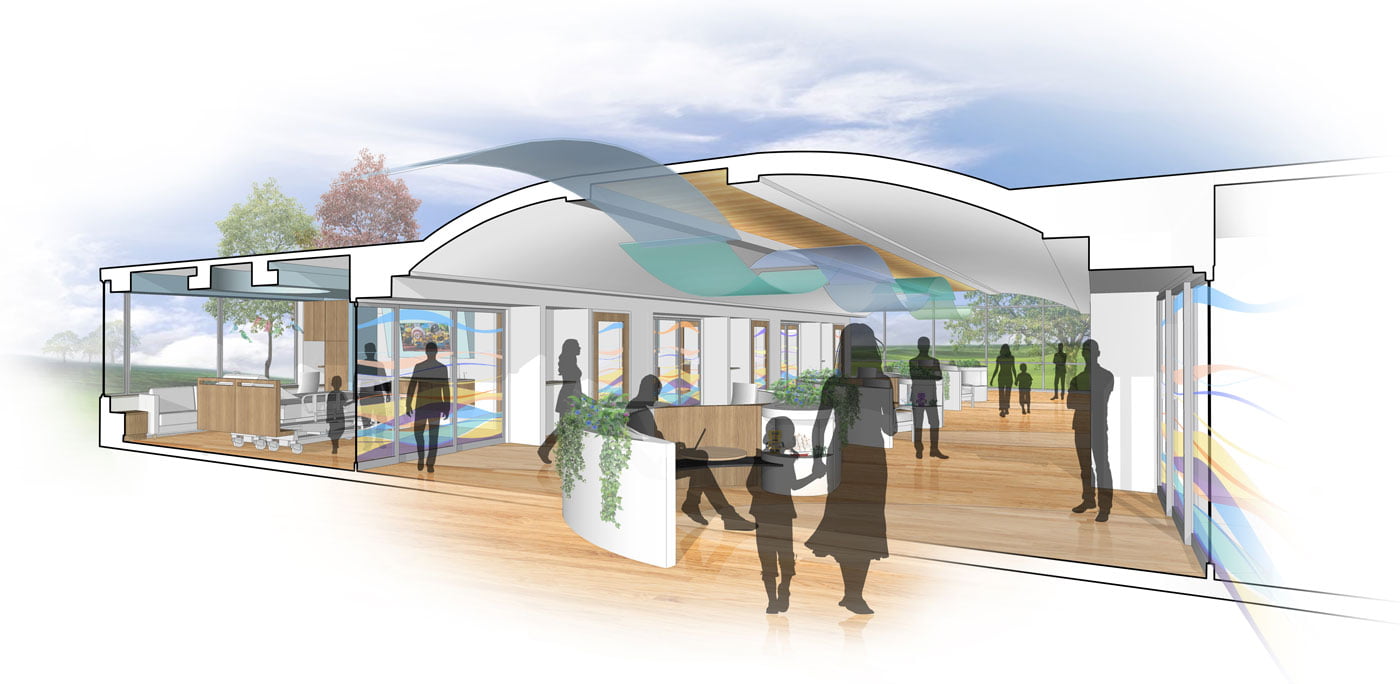
In addition to the movement toward an ambulatory strategy, medical providers are embracing integrated, team-based care. This care model is also changing the physical characteristics of the environment of care. There is a need for consolidated staff space, planned and designed to support collaboration among multiple team members, often approached by utilizing the on-stage/off-stage strategy. This space is concealed, allowing care teams to meet and collaborate on patient medical files and treatment plans, coordinate care plans with ancillary services, and consult with families. Done behind closed doors, this keeps the patient care environment free from the noise, clutter, equipment and distractions associated with older care delivery models where this function is embedded within the patient care space. Using this model, the environment of care is completely focused on the patient, the premise for patient-centered care.
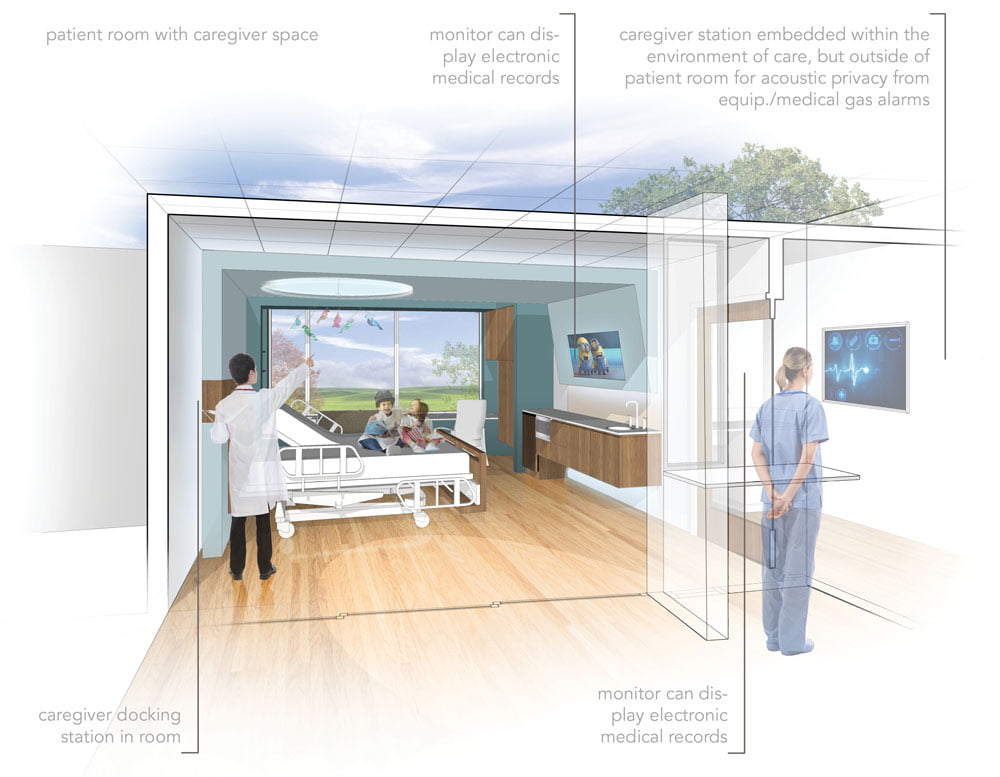
When a family like the Willes has such a personal and emotional experience and are willing to publicly share their story on behalf of their son, the healthcare profession has a moral obligation to listen and respond. More importantly, the healthcare design profession must be willing to join their story and help facilitate the journey, effecting positive change in the built environment for patients and their families. The goal is simple: to put patients and their families first. We must not only listen, but hear and understand their concerns and then respond. Hendo’s story is a must-read for all healthcare and healthcare design professionals.
The most important message we heard in Hendo’s story is the notion their environment of care becomes a home, and all aspects of care within this space must reinforce the experiences of home. The length of stay (in Hendo’s case one such stay was 41 days) is substantial and as such, the staff become members of the family, and other patients and their families become neighbors, underlining the sense of community. This sense of community supports social interactions and builds friendships, which contribute to the environment of care, often overcoming the negative stigma of having to return to this place, should the patient be discharged but have to be readmitted due to their condition or progression of the disease. The sense of family and community are crucial, and the architecture and design of this environment of care must respond.
Accordingly, we believe the environment of care must be layered in terms of the space and a transition from public space, to semi-public/semi-private, to private. These basic tenets of well-designed space are often missing in healthcare architecture. The patient and their family must have the ability to choose their level of engagement both within this space and within the neighborhood or department/unit of care. The concept design responds by providing living space (public zone) where they may engage their neighbors as they choose, and a bedroom space, which can be left open to the living space for semi-public/semi-private-type experiences, or closed for complete privacy when the need arises. This layering of space empowers the patient and their family to control their engagement within the environment of care.
Within the bedroom space, the patient and their family have control over their environment. The space is centered on the family bed, which is located under a canopy, an organizing feature of the room that connects the headwall and footwall and is the source of lighting, air and ventilation of the space. The patient has control of the temperature and lighting, with the ability to adjust those settings as desired.
Central to this concept is the family bed. In Hendo’s story it is clear the notion of family and togetherness is crucial. The family bed provides the ability for family to be together – to play and cuddle, and most importantly for the parent(s) to room-in and sleep with their child during treatment. While we see it as a large, king-size bed, we envision the bed will have the ability to come apart if/when needed for patient treatment or emergencies.
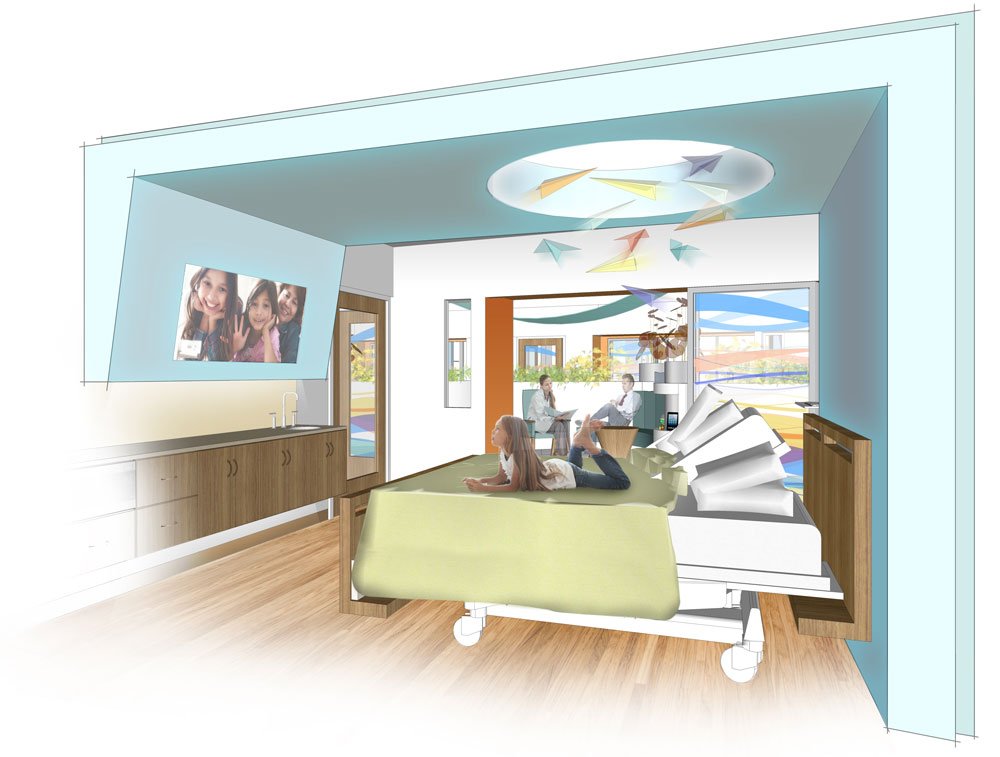
The bed is enveloped by the patient room headwall, canopy, and footwall element. An internally lit design element, which conceals the medical technology and systems for treatment, provides lighting. The patient can control this as they desire, as they can the television monitor, which is used for entertainment, communication and electronic medical record sharing. The large family bed engages the entire family in the process of care, increasing communication and collaboration, which contributes to a reduction in the use of medications.
Healthcare needs to respond more aggressively to the notion that human touch, cuddling, and closeness of family during difficult and frightening experiences as part of the regime of care is a good thing. Families that desire this type of care experience should have this choice as long as the quality of care is not compromised.
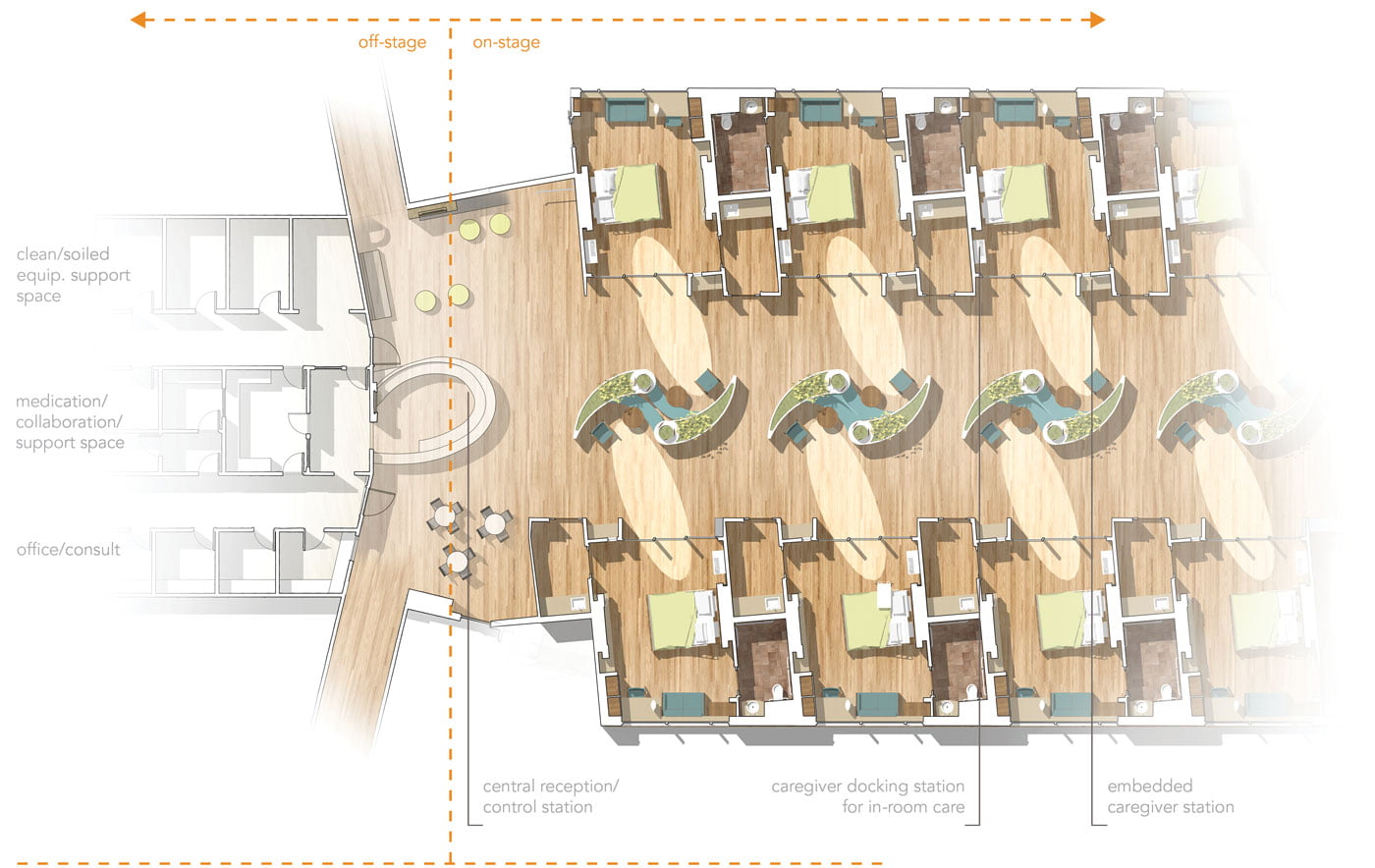
Our concept embraces the on-stage /off-stage strategy for staff and their support functions. We envision an integrated care team collaboration space along with the obligatory clean and soiled rooms, medication safety zone, housekeeping and other such support spaces within an area adjacent to the open living spaces.
Nursing and staff work alcoves are provided just outside of each patient room. This space would also contain the medical gas and equipment alarms, removing those from the patient’s room in order to enhance privacy and reduce noise and distractions. This alcove has a view of the patient bed, allowing nurse visualization when necessary. We also propose a flip-down charting station within the room, allowing nurses and doctors to work and chart within the room as needed.
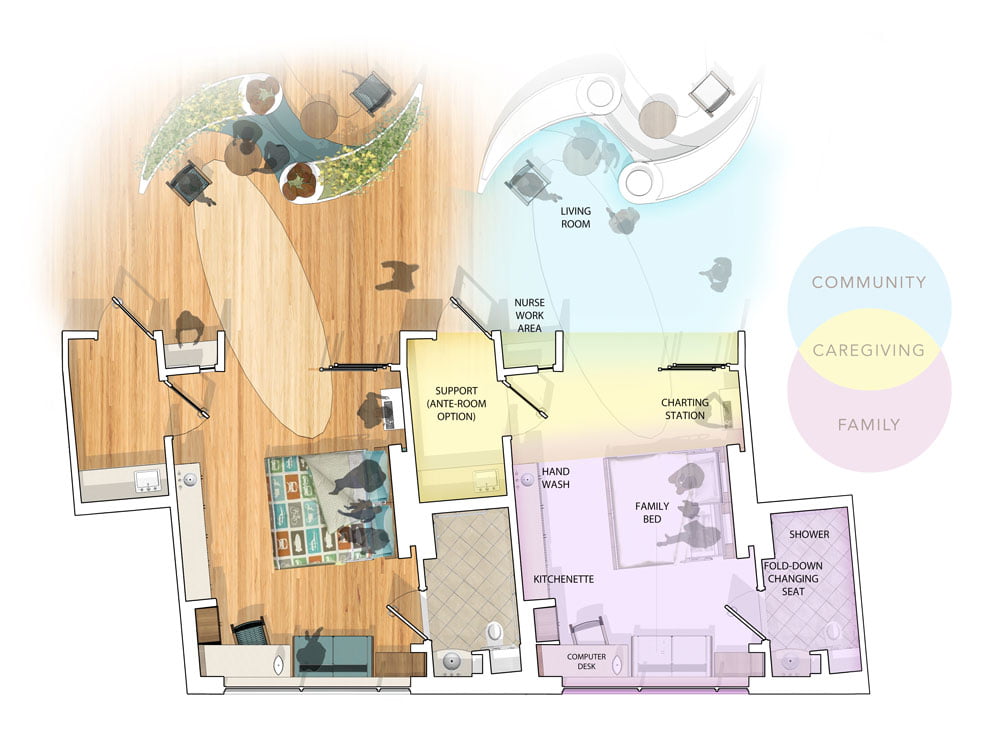
Working together, these elements allow the patient and their family to better control their own environment and their level of engagement, all the while having staff embedded within the space to deliver care without compromising the sense of community, space and place.
The 10 Principles of Patient and Family-Centered Design
The Center for Health Design and the Institute for Patient-Centered Design are great resources for exploring and developing this concept. Our team embraced the 10 Principles of Patient and Family-Centered Design:3
Respect privacy.
The proposed design provides the patient and their family with an array of choices to respect their privacy during the delivery of care in this environment. The patient is able to choose their level of engagement, always secure with the ability to retreat to their family bed for privacy.
Facilitate communication, collaboration, and trust.
The proposed design integrates technology to support the communication and collaboration between patient, family members and care providers. In addition, the care team is embedded within the care environment, eliminating the physical barrier often present when traditional nursing stations are utilized.
Encourage patient and family participation.
Through the layering of space from private to public scenarios, the care environment will promote participation by the patient and their family to the extent they are comfortable. The integration of medical technology within these spaces will encourage their participation at a very high level.
Empower patients.
Having choices available on how to use the environment of care space will empower the patient and their family. Additionally, staff will be empowered to gauge their level of care and interaction with the family members depending on how they are using the space (i.e., in the living room, more public/more collaboration. In the family bed/bedroom, more privacy/more tact and structure for communication).
Promote safety and security.
Having the ability to retreat to the family bed/bedroom provides an enhanced sense of safety and security. Technology and other strategies, such as patient ceiling lifts, can be deployed within the bedroom to enhance safety.
Provide accessible accommodations.
The proposed design is completely accessible, utilizing the required clearances for wheelchair and stretcher access and transfers to/from the bed. The family bed is proposed to utilize two halves, each fully adjustable to permit patient access and transfer from a fully reclined to even a seated position. All of the related spaces as part of the proposed design are based on accessibility guidelines and ergonomic design standards – all of which would be scaled/adjustable to handle pediatric, juvenile and/or adult patients.
Create a comfortable environment.
The proposed design attempts to emulate a home-like environment by establishing the bedroom as the private zone, utilizing family-sized bed as the centerpiece of this space. The bed will accommodate just the patient – in a reclined or seated position, and one or more family members should they all wish to be together. The bed can separate should the need arise during treatment or in the event of an emergency. The public zone is the living room outside of the bedroom and in this zone the patient and family members may choose to socialize among themselves or with their neighbors. Here the patient may receive treatment in a chair – reclined or seated upright, or at the table so they may eat or play games if they choose. This space is designed to be highly interactive and engaging while also permitting the care providers to have visual control and access.
Facilitate healing.
Our team believes the proposed design will support a high level of care in an environment that embraces patient and family-centered design which research shows will facilitate healing. With a high level of choice and the ability to utilize several different layers of space in which to receive care, we believe the patient will be able to surround themselves with family in a home-like environment, reinforcing the sense of place and grounding those feelings in a more positive environment. This in turn reinforces the principles of mind, body and spirit, and is more conducive to healing.
Support staff’s goals through design.
The proposed design represents the “on-stage” environment for staff and must be supplemented with “off-stage” space for integrated care teams, support and facility services, and spaces for care providers to seek respite and solace.
Look for design opportunities to respond to unmet needs.
Our team believes the proposed design responds directly to the unmet needs of patients and their families under the current regime of cancer care and the spaces designed to support such care. Furthermore, we believe there is evidence supporting the notion that outpatient and inpatient cancer care must consider patient and family-centered principles in the planning and design of such space. Combined with on-stage/offstage strategies for the deployment of integrated care team space, storage and support spaces, and staff respite and support spaces, we believe this proposed design represents a viable model for consideration by leading cancer care organizations across the United States.
In following the evidence-based design process to create the design concept, we conducted a literature search to gather findings related to family-centered care in the pediatric care environment, and cancer care.
The literature on family-centered design can be organized into two areas: the health benefits associated with family/parental involvement and then possible design strategies to accommodate this involvement. In addition, our design solution incorporated evidence-based design findings related to effective and satisfying pediatric care environments.
"We are not inpatients or outpatients, but rather simply patients, and the care we require should not force our travel between multiple locations and providers."
- Dr. Rozanne Hug Wille
Family Presence – Improved Health Outcomes
A growing body of research demonstrates that family presence during healthcare procedures decreases anxiety for the child and the parents, and yields improved patient and family outcomes. For the patients, this includes less suffering (crying, restlessness), less medication, faster recovery times, and shorter length of stays.
For parents, possible improved outcomes include increased understanding and sharing in decision making with caregivers and an increased sense of respect from the medical team.
Children have the added comfort of their parents’ presence and parents are given the opportunity to witness procedures, reducing their questions and concerns. Once the family is properly informed the care providers can support the family with decisions regarding care. Keeping open and honest communication between the family and hospital staff improves the family’s emotional state and enhances the staff’s ability to treat the patient.
Many of these benefits can also apply to family involvement before and after procedures. For example, families specify that rounds are better when a nurse is present, when the family is introduced and involved in the discussion, and when medical terminology is avoided or interpreted.
Family Zone – Improved Health Outcomes
Design strategies that accommodate family-centered care support the health benefits summarized above. In addition, there is a body of research that suggests that there is a relationship between including a family zone in a patient room and the following health outcomes:
- Reduced patient falls
- Reduced patient stress
- Reduced patient depression
- Improved patient privacy and confidentiality
- Improved communication with patients & family members
- Improved social support
- Increased patient satisfaction
Pediatric Environments
Although the majority of research linked to pediatric environments is not particularly conclusive, it does focus on several key design strategies aimed at reducing patient anxiety or improving patient experience including the use of art, color, and positive distractions.
In summary, recent research suggests that the use of non-pharmacological interventions can be very effective in reducing patient anxiety and improving patient experience. This includes the use of art, color and other positive distractions (such as videos on a flat-screen TV monitor). Generally, the combination of bright colors, engaging themes, and nature content is consistently highly rated by pediatric patients. However, pediatric preferences vary significantly among age groups, so one should be careful before using the one-size-fits-all approach.
While the principles of patient-centered design formed the framework, the applicable research provided a basis for our hypothesis, to which our design team responded.
We believe the locus of healthcare and practice of medicine is moving rapidly to the outpatient environment, and the entire notion and definition of a hospital is changing. The spaces and environments of care must respond as the line between inpatient and outpatient becomes blurred.
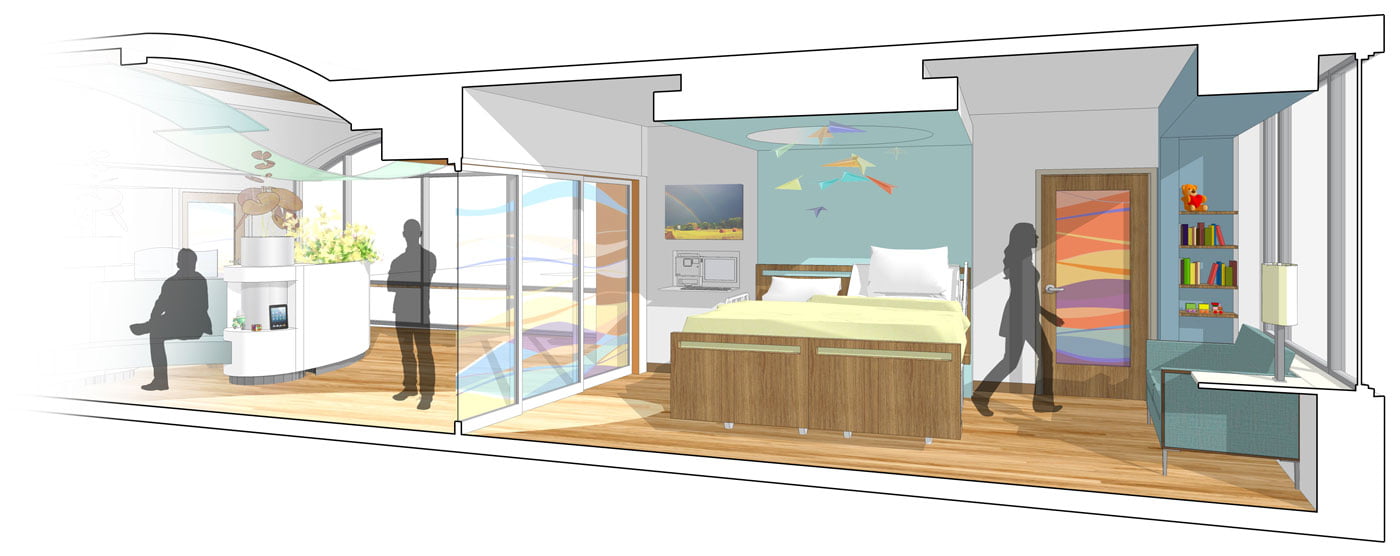
Our team was completely moved by Hendo’s story and his mother’s comment during the presentation of our design to the competition jury: “We are not inpatients or outpatients, but rather simply patients, and the care we require should not force our travel between multiple locations and providers.” Architecture and design can easily solve this challenge, but it will take a concerted effort and collaboration between designers, providers, patients and their families in order to reach a solution that can be efficiently operationalized in the realm of healthcare regulations, codes and reimbursement requirements. As architects, we would rather place our work on display for critique, comment and debate, in lieu of regurgitating and replicating the relics of healthcare’s past.
As a result of winning the competition, ERDMAN has been able to build an ongoing partnership with the Institute for Patient-Centered Design. The Institute facilitated the build-out of a mockup of the patient room and outer living room area, which has been used to solicit feedback from our peers in the industry and other stakeholders including practitioners and patients and their families. ERDMAN will continue its partnership with the Institute to test our hypothesis by way of simulated patient experiences in the full-scale mockup.
Our team was part of the inaugural Innovation Summit where the mockup was unveiled and initially tested. Data from the Summit will be collected, so the mockup may be refined. It will reside in the Institute’s sponsored showroom at OFS Brands in Nashville, Tennessee over the course of the next several years, during such time as our team will assimilate the data, run simulation modeling and reports. Following this period of time, the mockup will be donated to the Medical University of South Carolina for use on their campus as an end-of-life care space. Our team looks forward to the opportunity to design and build an installation of this concept wherein it may later be widely implemented and operationalized. Using the data and research from this effort to test and validate the concept, we envision it serving as a basis for change in the environment of care for cancer patients and their families.
- Radeva, J. I., VanScoyoc, E., Smith, F. O., Curtis, L. H., & Breitfeld, P. P. (2005). National estimates of the use of hemato poietic stem-cell transplantation in children with cancer in the United States. Bone marrow transplantation, 36(5), 397-404. http://www.nature.com/bmt/journal/v36/n5/full/1705077a.html#close http://www.nature.com/bmt/journal/v36/n5/fig_tab/1705077t4.html#figure-title
- Footnote “Building and Life Safety Codes, Facility Guidelines, and Departments of Health Rules and Regulations, Division of Nursing and Licensure Regulations
- Conway, J., Johnson, B., Edgman-Levitan, S., Schlucter, J., Ford, D., Sodomka, P., Simmons, L. (June 2006). “Partnering with patients and families to design a patient- and family-centered healthcare system.” Institute for Patient- and Family-Centered Care. http://www.ipfcc.org/pdf/Roadmap.pdf
Bibliography A: FAMILY PRESENCE – Improved Healthcare Outcomes
American Academy of Pediatrics, Policy Statement: Patient- and Family-Centered Care and the Pediatrician’s Role, 2012
Neff, J. M. (2003). Family-centered care and the pediatrician’s role: A policy statement. American Academy of Pediatrics,112(3).
Cameron, M. A., Schleien, C. L., & Morris, M. C. (2009). Parental presence on pediatric intensive care unit rounds. Journal of Pediatrics, 155(4), 522–528.
Muething, S. E., Kotagal, U. R., Schoettker, P. J., Gonzalez del Rey, J., & DeWitt, T. G. (2007). Family-centered bedside
rounds: A new approach to patient care and teaching. Pediatrics, 119(4), 829–832.
Romano, J. (1941). Patients’ attitudes and behavior in ward round teaching. JAMA, 117, 664–667. 31.
Lewis, C., Knopf, D., Chastain-Lorber, K., Ablin, A., Zoger, S., Matthay, K., et al. (1988). Patient, parent, and physician perspectives on pediatric oncology rounds. Journal of Pediatrics, 112(3), 378–384.
Lehmann, L. S., Brancati, F. L., Chen, M. C., Roter, D., & Dobs, A. S. (1997). The effect of bedside case presentations on patients’ perceptions of their medical care. New England Journal of Medicine, 336(16), 1150–1155.
Landry, M. A., Lafrenaye, S., Roy, M. C., & Cyr, C. (2007). A randomized, controlled trial of bedside versus conference-room case presentation in a pediatric intensive care unit. Pediatrics, 120(2), 275–280.
Latta, L. C., Dick, R., Parry, C., & Tamura, G. S. (2008). Parental responses to involvement in rounds on a pediatric inpatient unit at a teaching hospital: A qualitative study. Academic Medicine, 83(3), 292–297.
Shelton TL, Stepanek JS. Family-Centered Care for Children Needing Specialized Health and Developmental Services. Bethesda, MD: Association for the Care of Children’s Health; 1994
Aronson, P. L., Yau, J., Helfaer, M. A., & Morrison, W. (2009). Impact of family presence during pediatric intensive care unit rounds on the family and medical team. Pediatrics, 124(4), 1119–1125.
Rosen, P., Stenger, E., Bochkoris, M., Hannon, M. J., & Kwoh, C. K. (2009). Family-centered multidisciplinary rounds enhance the team approach in pediatrics. Pediatrics, 123(4), e603–e608.
Fina DK, Lopas LJ, Stagnone JH, Santucci PR. Parent participation in the postanesthesia care unit: fourteen years of progress at one hospital. J Perianesth Nurs. 1997;12(3):152–162 Saleeba, A. The Importance of Family-Centered Care in Pediatric Nursing. University of Connecticut School of Nursing, Scholarly Works. 2008.
http://digitalcommons.uconn.edu/cgi/viewcontent.cgi?article=1051&context=son_articles
Bibliography B: FAMILY ZONE – Improved Healthcare Outcomes
Ulrich RS1, Zimring C, Zhu X, DuBose J, Seo HB, Choi YS, Quan X, Joseph A. A Review of the Research Literature on Evidence-Based Healthcare Design. HERD. 2008.
Astedt-Kurki, P., Paavilainen, E., Tammentie, T., & Paunonen-Ilmonen, M. (2001). Interaction between adult patients’ family members and nursing staff on a hospital ward. Scandinavian Journal of Caring Sciences.
Kaldenburg, D. o. (1999). the influence of having a roommate on patient satisfaction. Press Ganey Satisfaction Monitor.
Laitinen, P., & Isola, A. (1996). Promoting participation of informal caregivers in the hospital care of the elderly patient: Informal caregivers’ perceptions. Journal of Advanced Nursing, 23(5), 942–947.
Bibliography C: PEDIATRICS
Pediatric Art Preferences: Countering the “One-Size-Fits-All” Approach HERD 2009 Summer; Nanda U, Chanaud CM, Brown L, Hart R, Hathorn K.
Pictorial Intervention in a Pediatric Hospital Environment: Effects on Parental Affective Perception of the Unit Journal of Environmental Psychology, 2012, Monti, F., Agostini, F., & Dellabartola, S., & Neri, E., & Bozicevic, L., & Pocecco, M.
The Healthcare Environment Through the Eyes of a Child – Does it Soothe or Provoke Anxiety? International Journal of Nursing Practice, 2012, Norton-Westwood, D.
Influence of Positive Distractions on Children in Two Clinic Waiting Areas HERD, 2011 Spring, Pati D, Nanda U.
Psychosocial Behaviors of Hospitalized Children: A Feasibility Study Journal of Pediatric Nursing, 2013, Colwell, C. M., & Edwards, R., & Hernandez, E., & Brees, K.
Young Children’s Perspectives of Ideal Physical Design Features for Hospital-Built Environments Journal of Child Healthcare, 2013, Lambert, V., & Coad, J., & Hicks, P., & Glacken, M.
Physical Activity in Pediatric Healing Gardens Landscape and Urban Planning, 2013, Pasha, S., & Shepley, M., M.
